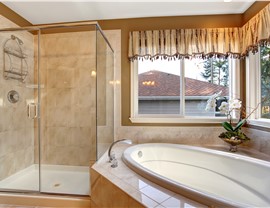Water damage in the bathroom can be a SILENT ENEMY, often going unnoticed until it leads to serious problems. Given the constant exposure to moisture and humidity, bathrooms are particularly susceptible to water damage which can compromise both aesthetics and structural integrity. Recognizing the early signs of water damage can save you from Costly Repairs and ensure your bathroom remains a safe and comfortable space. Let’s guide you through the common indicators of water damage in your bathroom and offer tips on how to address them effectively.
How To Spot Water Damage
1. Peeling Paint or Wallpaper
If you notice peeling or bubbling paint or wallpaper it could be a sign of moisture buildup behind surfaces, this often indicates a leak or excess humidity that needs to be addressed!
2. Mold and Mildew
Mold and mildew thrive in damp environments! If you spot black or green spots on walls, ceilings, or grout lines it could be a sign of water damage. Mold in the bathroom can pose significant health risks particularly for individuals with respiratory issues, allergies, or weakened immune systems! When mold spores are inhaled, they can trigger allergic reactions, such as sneezing, coughing, and skin rashes. In severe cases, certain types of mold, like black mold, can produce mycotoxins that may cause more serious health problems.
3. Soft or Warped Walls
Walls that feel soft to the touch or appear warped are also an indication of water damage, this usually means that water has penetrated the drywall, plaster or substrate compromising its structural integrity.
4. Musty Odor or Discolored Surfaces
A persistent musty odor in your bathroom is often a sign of hidden water damage! This smell is caused by mold and mildew growth, which can occur behind walls or under flooring. Stains or discoloration on ceilings, walls, or floors are common signs of water damage. Yellow, brown, or dark spots often indicate a leak from some sort of water infiltration.
5. Cracked or Loose Tiles
Cracked or loose tiles can be caused by many things. Tiles cracking or becoming loose can be a result of water infiltration and this can lead to further damage if not repaired as water will continue to penetrate the subfloor or walls.
How to Address Water Damage
If you notice any of these signs, it is important to take action immediately!
- Identify the Source: Determine where the water is coming from. Which may involve inspecting plumbing fixtures, checking for roof leaks or examining grout and sealants for wear.
- Repair Leaks: Fix any leaks promptly to prevent further damage. Which may involve tightening connections, replacing fixtures or re-grouting tiles.
- Dry the Area: Use fans and dehumidifiers to dry out damp areas and reduce humidity which will help prevent mold growth and further damage.
- Call a Professional: For significant water damage it’s best to consult a professional, they can assess the extent of the damage and recommend appropriate repairs!
By staying vigilant and addressing signs of water damage early, you can protect your bathroom from further harm and maintain a safe, comfortable environment. Regular maintenance and inspections can also help prevent future issues and ensure your bathroom remains in top condition.
How to Prevent Water Damage
Preventing water damage in your bathroom is essential for maintaining a safe and functional space, here are some key strategies to help you avoid costly repairs:
- Hire a Trusted Professional: Ensure all plumbing work is performed by a licensed professional to help prevent leaks and faulty installations. Regular maintenance and inspections can identify potential issues before they become major problems.
- Proper Ventilation: Install an exhaust fan to remove excess moisture from the air which in turn will help by reducing the risk of mold and mildew growth. Make sure the fan is appropriately sized for your bathroom and use it during and after showers to keep humidity levels low, opening a window in the bathroom can also be a great way to allow proper airflow to reduce risk of water damage.
- Sealant and Caulking: Regularly inspect and maintain caulking around bathtubs, showers, and sinks. Replace any damaged or deteriorated sealant to prevent water from seeping into walls and floors. Caulking is often considered a “wearable” item meaning it does need replaced over time. Cracks in the caulking can lead to unseen damage.
- Use Water-Resistant Materials: Water-resistant materials such as moisture-resistant drywall and waterproof paint can minimize the risk of water damage in areas prone to moisture exposure. Be aware that some tile, which is a popular choice for bathrooms, is porous and can absorb moisture over time. This can lead to the growth of mold and mildew beneath the tile surface, especially if grout is not properly sealed. Regularly sealing grout can help reduce porosity and protect your bathroom from water infiltration.
By following these preventative measures, you can significantly reduce the risk of water damage in your bathroom! Regular maintenance and vigilance are key to protecting your home from costly repairs and ensuring long-term functionality. If you think you may have water damage from your shower/bathtub have Optum come out and give you a free consultation, the Consultant can help identify some of the issues and plan your next steps!



